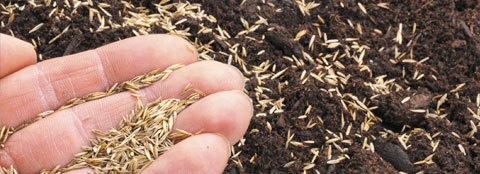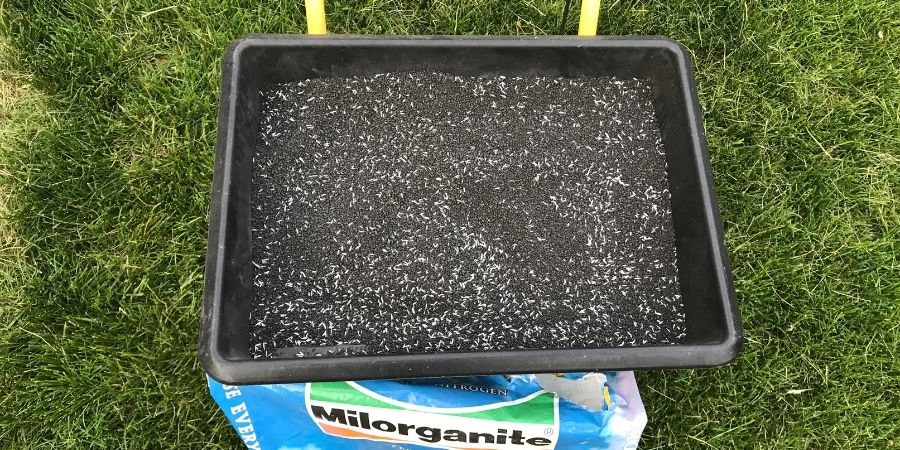Seed, Sod, Sprig, Plug Milorganite® Application Rates

Milorganite® Accelerates New Lawn Growth and Development
When seeding your lawn or laying sod, sprigs, or plugs, add Milorganite to accelerate development. The salt-free formula will never burn tender new roots, and the iron generates a deep, lasting green.
Mix Milorganite into the soil when seeding, laying sodding, or planting plugs and sprigs, (see the chart for application rate based on your soil type)
| Soil Type | Seeding & Sodding | Sprigging & Plugging |
|---|---|---|
| Sand | 50-100 lbs* | 50-100 lbs* |
| Native soil | 25-50 lbs* | 25-50 lbs* |
Use the higher rates for grass types that prefer higher nitrogen (Kentucky bluegrass or Bermuda grass) and in soils with low organic matter that have very infertile root zones.
*New lawns in VA apply Milorganite 32 lb. per 2,500 sq ft, and in FL, only apply Milorgnaite two times per year at the rate of 32 lbs. per 5,200 sq ft (per state regulations). Check with local ordinances for fertilizer blackout dates.
How to Seed a New Lawn or Filling in Bare Patches with Milorganite®
Prepare your soil by incorporating several inches of organic matter, such as compost and Milorganite, into the top 6-8 inches. View the chart for the Milorganite application rate based on your soil type.
When filling a bare patch in your lawn you can mix grass seed and Milorganite and spread it evenly on the prepared soil. Gently work the seed and Milorganite mix into the soil 1/16 to 1/8 of an inch. Light (sandy) soils may only require watering for seed incorporation.
Keep the seeded area moist until the seeds emerge. The seedlings need frequent gentle watering until ½ to 1 inch tall. When conditions allow, reduce watering several times a week at a depth of 1 to 2 inches. Decrease the frequency and increase the depth of watering as seedlings mature.
After you have mowed your new lawn three times, then apply 64 lbs. of Milorganite per 2,500 sq ft. Check out the Milorganite agronomist's journey when starting her new lawn from seed or for tips on how to patch bares spots in your lawn.
Overseeding with Milorganite®
Milorganite is a great fertilizer for overseeding. Mixing grass seed with Milorganite is an effective way to spread seed accurately. Mix 4 parts Milorganite with 1 part seed by weight. If you choose to mix Milorganite and seed, be careful to decrease future applications of Milorganite to prevent over-fertilization.

| Seed Type | Milorganite (lbs) | Seed (lbs) | Seed per 1,000 sq ft | Area Covered (sq ft) | Milorganite per 1,000 sq ft |
|---|---|---|---|---|---|
| Bentgrass | 20 | 5 | 1 lb | 5,000 | 4 lbs |
| Bermuda Grass | 20 | 5 | 1 lb | 5,000 | 4 lbs |
| Blue Grass | 100 | 25 | 4 lbs | 6,250 | 16 lbs |
| Blue-Rye Mix | 100 | 25 | 6 lbs | 4,250 | 23 lbs |
| Rye Grass | 100 | 25 | 8 lbs | 3,250 | 30 lbs |
Sodding a Lawn with Milorganite®
First, prep your soil by incorporating several inches of organic matter, such as compost, into the top 6-8 inches of soil. Milorganite should be mixed into the top 2-4 inches of soil before laying sod to help establish and feed the roots.
After laying new sod, water enough to penetrate the sod and 2 inches of the existing soil. On day two and moving forward, keep your sod and soil moist throughout the day. The roots are short so the sod cannot take large amounts of water at any single time. Other than the first day, the ground under the sod should never be soggy. Watering 4 to 6 times during the day, for approximately 5 to 6 minutes each time, is usually required until the roots are established. Root establishment will usually begin within 7 to 14 days.
After two weeks, reduce the frequency of times you water at a gradual pace. You can confirm the establishment of the roots by pulling up a corner of the sod, and if you feel some resistance, you can begin tapering off the frequency of watering until you are watering only once per day. Deeper, less frequent watering will help roots stretch down deeper and establish quickly into the soil. Once fully established, a lawn needs approximately 1 inch of water per week.
After mowing your new lawn at least three times, apply 64 lbs. of Milorganite fertilizer per 2,500 sq ft to help establish roots and accelerate development. Wait 6-8 weeks before applying Milorganite again follow a seasonal fertilization schedule for your grass variety and climate. Check out our blog on "How to Lay Sod" for more detailed instructions and tips.
Planting Sprigs with Milorganite®
Planting of warm-season grass sprigs (3- to 6-inch pieces of grass stems or runners without soil) should be in late spring to early summer to allow for the longest period of time for optimal growing conditions, above 70 degrees.
Sprigging is less expensive than sodding, but it takes longer for the lawn to establish. Prep the soil before planting by incorporating several inches of organic matter such as compost and Milorganite into the top 2-4 inches of soil to aid in root establishment. Sprigs should be planted end-to-end in furrows 6–12 inches apart. Sprigs contain nodes, nodes are the part of a plant stem from which one or more leaves emerge, often forming a slight swelling or knob.
Place the nodes in direct contact with the soil. Sprigs should then be covered with soil, but leaf blades should be exposed and lightly roll the area to make sure the sprigs are level with the surrounding ground. Keep the area moist until the grass becomes established.
After mowing your new lawn at least three times, apply Milorganite fertilizer to help establish roots and accelerate development.
Planting Plugs with Milorganite®
Planting of warm-season grass plugs (3”x 3” chunks of sod with soil around their roots) should be in late spring to early summer to allow for the longest period of time for optimal growing conditions, above 70 degrees.
Prep the soil before planting by incorporating several inches of organic matter, such as compost and Milorganite, into the top 2-4 inches to aid in root establishment. Dig holes 6 to 12” deep, lightly water the area, press the plug firmly into the hole, and lightly roll the area to make sure the plugs are level with the surrounding ground. Keep the area moist until the grass becomes established.
After mowing your new lawn at least three times, apply Milorganite fertilizer to help establish roots and accelerate development.





